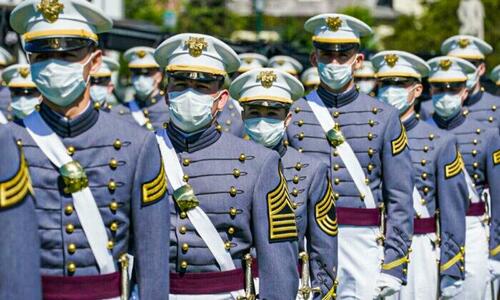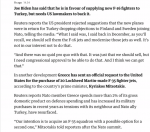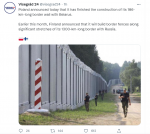Good observation!
The MSM is already hinting at a draft.
-------------
Every branch of the military is struggling to make its 2022 recruiting goals, officials say
With a record low number of Americans eligible to serve, and few of those willing to do it, this "is the year we question the sustainability of the all-volunteer force,” said an expert.
June 27, 2022, 3:30 AM CDT
By
Courtney Kube and Molly Boigon
Every branch of
the U.S. military is struggling to meet its fiscal year 2022 recruiting goals, say multiple U.S. military and defense officials, and numbers obtained by NBC News show both a record low percentage of young Americans eligible to serve and an even tinier fraction willing to consider it.
The officials said the Pentagon’s top leaders are now scrambling for ways to find new recruits to fill out the ranks of the all-volunteer force.
Defense Secretary Lloyd Austin and Deputy Secretary of Defense Kathleen Hicks consider the shortfall a serious issue, said the officials, and have been meeting on it frequently with other leaders.
“This is the start of a long drought for military recruiting,” said Ret. Lt. Gen. Thomas Spoehr of the Heritage Foundation, a think tank. He said the military has not had such a hard time signing recruits since 1973, the year the U.S. left Vietnam and the draft officially ended. Spoehr said he does not believe a revival of the draft is imminent, but “2022 is the year we question the sustainability of the all-volunteer force.”
The pool of those eligible to join the military continues to shrink, with more young men and women than ever disqualified for obesity, drug use or criminal records. Last month, Army Chief of Staff Gen. James McConville testified before Congress that
only 23% of Americans ages 17-24 are qualified to serve without a waiver to join, down from 29% in recent years.
An internal Defense Department survey obtained by NBC News found that
only 9% of those young Americans eligible to serve in the military had any inclination to do so, the lowest number since 2007.
The survey sheds light on how both Americans’ view of the military and the growing civilian-military divide may also be factors in slumping recruitment, and how public attitudes could cause recruiting struggles for years to come.
More than half of the young Americans who answered the survey — about 57% — think they would have emotional or psychological problems after serving in the military. Nearly half think they would have physical problems.
“They think they’re going to be physically or emotionally broken after serving,” said one senior U.S. military official familiar with the recruiting issues, who believes a lack of familiarity with military service contributes to that perception.
Among Americans surveyed by the Pentagon who were in the target age range for recruiting,
only 13% had parents who had served in the military, down from approximately 40% in 1995. The military considers parents one of the biggest influencers for service.
An expert on military personnel policy says that middle class parents, including those who are newly middle class, often encourage their kids to go to college before selecting a career, which hurts recruiting for enlisted personnel. “Changing the mind of parents is the really tough part, particularly if these are parents who worked really hard for their children to go to college,” said Kate Kuzminski from the Center for a New American Security. She noted that recruiting ads increasingly target the parents of potential recruits. “That’s where they’re trying to win the hearts and minds.”
Overall confidence in U.S. government institutions is also decreasing, and that has hit the U.S. military as well. In 2021 the annual Reagan National Defense Survey, conducted by the Ronald Reagan Presidential Foundation and Institute,
found that just 45% of Americans had a great deal of trust and confidence in the military, down 25 points since 2018.
The trend will most likely continue as the overall military shrinks and familiarity with service keeps dropping, say the officials. In 2021, an Army study found that 75% of Americans ages 16-28 knew little to nothing about the Army.
“This recruiting crisis is like a slow-moving wave coming at us,” said one senior defense official involved in recruiting and personnel issues. “As the military has gotten smaller and the public have gotten less and less familiar with those in uniform, it has grown. And Covid accelerated it.”
A Pentagon spokesperson declined to comment.
This year’s numbers so far
The Army has met about 40% of its enlisted recruiting mission for FY22, with just over three months left in the fiscal year, which ends Sept. 30. The final quarter — the summer — is typically when the services recruit the most candidates following high school graduation.
Space Force will also likely make its goal, according to U.S. military officials, but as the newest branch of the military it only looks to recruit about 500 Guardians this fiscal year.
The U.S. Air Force, on the other hand, has to recruit roughly 100 times as many airmen, about 50,000, but is currently more than 4,000 below where it should be at this point in the fiscal year. While the Air National Guard and Reserve are unlikely to meet their goals, the active duty are taking it week to week, according to a senior U.S. military official. “We are hopeful that the active duty will meet their goal. Hopeful, but not certain,” the official said.
The last time the Air Force missed its goal was fiscal 1999, and the last time before that was 1979.
Navy officials, who have been using the summer movie “Top Gun: Maverick” to try to attract recruits, say they hope to ultimately meet their active-duty and overall strength goals.
The active-duty Marine Corps is likely to make its recruiting goals this year. The Marine in charge of manpower, however, recently told Congress that 2022 is “arguably the most challenging recruiting year since the inception of the all-volunteer force.”
The Coast Guard is lagging behind its active-duty numbers for the year. It has met 80% and 93% of its goals for reserves and officers respectively, but has filled only about 55% of its target of 4,200 active-duty enlistments.
How to fix it
To tackle the growing crisis, the Pentagon is reviewing some of the more than 250 disqualifiers for service, including some medical conditions that have historically required recruits to obtain a waiver for service or kept individuals out of uniform completely, according to multiple defense and U.S. military officials.
For example, in the past ailments like asthma and ADHD could disqualify someone from serving if the recruit had symptoms after their 13th or 14th birthdays. But now the Pentagon is reviewing whether individuals who have been asymptomatic for a shorter period of time could join without a waiver.
The military is also discussing allowing
service members to use platforms like TikTok to attract recruits. In 2020, President Donald Trump ordered a ban on the use of the social media platform because the Chinese company that owns it collects biometric information on users.
“We have to be where the recruits are, and TikTok is one of the biggest social media platforms in the world,” one defense official involved in personnel issues said.
The Pentagon is also looking to increase recruitment by targeting more influencers like parents, teachers and coaches, by creating recruiting stations with multiple services in them rather than service specific locations, and even moving recruiting offices to better neighborhoods, according to multiple U.S. military and defense officials.
The Pentagon may also put more effort into recruiting eligible DACA recipients, said officials.
Long-term challenges like declining eligibility and trust in the military are only part of the issue, according to defense and U.S. military officials. More recent challenges like a national labor shortage, inflation and the effects of Covid have also affected recruitment. Two years of Covid has led to canceled air shows, a drastic decrease in in-person recruitment efforts, and more people now wanting to work from home.
Kuzminski agrees that Covid hurt recruiting, but adds that another challenge has been political pressure in some school districts not to let recruiters on campuses. Face-to-face meetings can be a powerful incentive to enlist.
Army Secretary Christine Wormuth recently created a recruiting “tiger” team, which meets every two weeks to discuss ways to tackle recruitment.
“The Army, like other services, is facing the most challenging recruiting market in the last 20 years,” Wormuth told NBC News. “I expect these recruiting market headwinds to persist, so the Army must improve how we recruit in this new market environment. In March 2022, the Army began a comprehensive review and analysis of our accessions enterprise, recruiting policy, organizational structure and marketing practices. Recommendations for this review, coupled with other immediate steps we are taking, will help the Army address recruiting challenges and position the Army recruiting for success in the future.”
The Army is offering flexible 2-year to 6-year contracts, duty stations of choice, a program where enlistees can be stationed with their friends,
and a $10,000 quick-ship bonus.
Some of the service branches are offering unprecedented bonuses for signing up or re-enlisting, up to $50,000 for certain specialties in the Army, Air Force and the Navy.
But one U.S. military official said bonuses can only help so much. “We can throw money at the problem all we want, but until we change how young people see us in uniform, we are going to struggle to get them to raise their right hands.”
Every branch of the U.S. military is struggling to meet its 2022 recruiting goals, officials say (nbcnews.com)
















